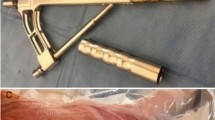Abstract
Introduction
Osteosynthesis of pertrochanteric fractures is one of the most frequently performed procedures in orthopaedic trauma care. Auto-dynamization during fracture healing can lead to lateralization of the screw or blade. This can cause debilitating complaints, which sometimes necessitate the removal of the screw or blade. After removal of the implant, we observed spontaneous femoral neck fractures in five patients. This article presents an evaluation of these cases with reference to literature.
Materials and methods
Five cases of spontaneous femoral neck fracture (SFNF) after cephalomedullary nail removal are described. A literature search was performed on the incidence of chronic pain and gait impairment associated with auto-dynamization, and on risk factors for dynamization and complications after implant removal. Based on these findings recommendations are made for the prevention of SFNF.
Results
Over a 2-year period, we observed five cases of SFNF after cephalomedullary nail removal. In literature, reduced mobility, gait impairment and chronic pain are associated with screw or blade dynamization. Pertrochanteric fractures with AO-type 2 classification were associated with more dynamization and screw lateralization and henceforth more trochanteric pain and gait disturbances. SFNF after cephalomedullary nail removal occurs with an incidence of at least 15%, affecting mostly elderly patients. This severe complication mostly occurs within 3 weeks after implant removal. Risk factors associated with SFNF are pre-existing systemic osteoporosis, stress-shielding, pre-loading of the implant and nail removal of the cephalomedullary implant.
Conclusion
The clinical indications for implant removal in healed pertrochanteric fractures are not well established and should be restricted to specific cases. After removal of these implants without replacement partial weight-bearing should be advised strictly. Based on our findings it is recommended to replace the cephalomedullary nail with a shorter one, ideally combined with implant augmentation.

Similar content being viewed by others
References
Miyamoto RG, Kaplan KM, Levine BR, Egol KA, Zuckerman JD (2008) Surgical management of hip fractures: an evidence-based review of the literature. I:femoral neck fractures. J Am Acad Orthop Surg 16:665–673
Zuckerman JD (1996) Hip fracture. N Engl J Med 334:1519–1525
Sandifer PA, Hullick RM, Graves ML, Spitler CA, Russel GV, Hydrick JM, Jones LC, Bergin PF (2017) Extent and morbidity of lateralization of a trochanteric fixation nail blade. Orthopedics 40(5):e886–e891
Fang C, Gudushauri P, Wong TW, Pun T, Leung F (2016) Increased fracture collapse after trochanteric fractures treated by the dynamic hip screw adversely affects walking ability but not survival. Biomed Res Int 2016:4175092
Gausden ED, Sin D, Lavack AE, Wessel LE, Moloney G, Lane JM, Lorich DG (2018) Gait analysis after trochanteric fracture: does shortening result in gait impairment. J Orthop Trauma 32(11):554–558
Velkes S, Nerubay J, Lokiec F (1996) Stress fracture of the proximal femur after screw removal. Arch Orthop Trauma Surg 115:61–62
Ponkilainen VT, Huttunen TT, Kannus P, Mattila VM (2020) Hardware removal rates after surgical treatment of proximal femur fractures. Arch Orthop Trauma Surg. https://doi.org/10.1007/s00402-020-03356-z
Barquet A, Giannoudis PV, Gelink A (2017) Femoral neck fractures after removal of hardware in healed trochanteric fractures. Injury 48(12):2619–2624
Buciuto R, Hammer R, Herder A (1997) Spontaneous subcapital femoral neck fracture after healed trochanteric fracture. Clin Orthop Relat Res 342:156–163
Barquet A, Giannoudis PV, Gelink A (2018) Femoral neck fractures after internal fixation of trochanteric fractures with implants in situ in adults: a systematic review. Injury 49(12):2121–2131
Kammerlander C, Pfeufer D, Lisitano LA, Mehaffey S, Böcker W, Neuerburg C (2018) Inability of older patients with hip fracture to maintain postoperative weight-bearing restrictions. J Bone Joint Surg Am 100(11):936–941
Shaer JA, Hileman BM, Newcomer JE, Hanes MC (2012) Femoral neck fracture following hardware removal. Orthopedics 35(1):83–87
Funding
There is no funding source.
Author information
Authors and Affiliations
Corresponding author
Ethics declarations
Conflict of interest
The authors declare that they have no conflict of interest.
Ethical approval
This article does not contain any studies with human participants or animals performed by any of the authors.
Additional information
Publisher's Note
Springer Nature remains neutral with regard to jurisdictional claims in published maps and institutional affiliations.
Rights and permissions
About this article
Cite this article
Driessen, M.L.S., Goessens, M.L.M.J. Complications of implant removal after healed hip fractures. Arch Orthop Trauma Surg 140, 1745–1749 (2020). https://doi.org/10.1007/s00402-020-03435-1
Received:
Published:
Issue Date:
DOI: https://doi.org/10.1007/s00402-020-03435-1




